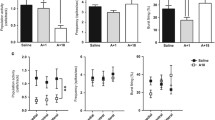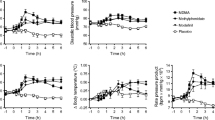Abstract
A modified hyponeophagia test is described as an animal model of anxiety. The effects of 0, 0.3, 1.0, 3.0 and 10 mg/kg diazepam, given both acutely and for 7 days pretest, were assessed in rats. Acutely, diazepam reduced hyponeophagia over the dose range 0.3–3.0 mg/kg but 10.0 mg/kg produced sedation and large variability. Chronically, the dose-response relationships were monotonic and the maximal effect was increased, suggesting that differential tolerance occurs to the sedative, but not to the anxiolytic, effects of this drug. Increased food deprivation did not mimic benzodiazepine effects on hyponeophagia, and actually prolonged eating latency in rats treated with 5-methoxy-N,N-dimethyltryptamine (2.5 mg/kg), which does not support an interpretation of diazepam effects in terms of appetitive actions. An arousal hypothesis of hyponeophagia was proposed and supported by the antagonism of the sedative effects of 10.0 mg/kg diazepam by d-amphetamine (0.5 mg/kg). Although both male and female rats were used throughout, sex differences were few in these studies.
Similar content being viewed by others
References
Bainbridge JG (1968) The effect of psychotropic drugs on food-reinforced behaviour and on food consumption. Psychopharmacologia 12:204–213
Barnett SA (1958) Experiments on “neophobia” in wild and laboratory rats. Br J Psychol 49:195–201
Bolles RC (1963) The readiness to eat and drink: The effect of deprivation conditions. J Comp Physiol Psychol 55:230–234
Broadhurst PL (1957) Determinants of emotionality, in the rat: I. Situational factors. Br J Psychol 48:1–12
Broadhurst PL, Eysenck HJ (1964) Interpretations of exploratory behaviour in the rat. In: Eysenck (ed) Experiments in motivation. Pergamon, Oxford, pp 375–389
Burton MJ, Cooper SJ, Posadas-Andrews A (1980) Interactions between chlordiazepoxide and food deprivation determining choice in a food-preference test. Br J Pharmacol 68:158P-159P
Cooper SJ (1980) Effects of chlordiazepoxide and diazepam on feeding performance in a food-preference test. Psychopharmacology 69:73–78
Cooper SJ, Burnett G., Brown K (1981) Food preference following acute or chronic chlordiazepoxide, administration: Tolerance to an antineophobic action. Psychopharmacology 73:70–74
Cooper SJ, Francis RL (1978) Feeding parameters in the rat: Interactions of chlordiazepoxide with d-amphetamine or fenfluramine. Br J Pharmacol 64:378P-379P
Dantzer R (1977) Behavioural effects of benzodiazepines: A review. Biobehav Rev 1:71–86
Geller I, Seifter J (1960) The effects of meprobamate, barbiturates, d-amphetamine and promazine on experimentally induced conflict in the rat. Psychopharmacologia 1:482–492
Gray JA (1971) Sex differences in emotional behaviour in mammals including man: Endocrine bases. Acta Psychol 35:29–46
Hall C (1934) Emotional behaviour in the rat. 1. Defecation and urination as measures of individual differences in emotionality. J Comp Psychol 18:385–403
Johnson DN (1978) Effects of diazepam on food consumption in rats. Psychopharmacology 56:111–112
Lát J (1963) The spontaneous exploratory reactions as a tool for psychopharmacological studies. A contribution towards a theory of contradictory results in psychopharmacology. In: Mikhelson, Longo (eds) Pharmacology of conditioning, learning and retention. Pergamon, Oxford, pp 47–66
Margules DL, Stein L (1968) Increase of “anti-anxiety” activity and tolerance of behavioural depression during chronic administration of diazepam. Psychopharmacologia 13:74–80
Mitchell D (1976) Experiments on neophobia in wild and laboratory rats: A re-evaluation. J Comp Physiol Psychol 90:190–197
Poschel B (1971) A simple and specific screen for benzodiazepine-like drugs. Psychopharmacologia 19:193–198
Poschel B, McCarthy D, Chen G, Ensor C (1974) Pyrazepam (Cl-683): A new anti-anxiety agent. Psychopharmacologia 35:251–271
Rushton R, Steinberg H (1966) Combined effects of chlordia zepoxide and dexamphetamine on activity of rats in an unfamiliar environment. Nature 211:1312–1313
Shephard RA (1980) Psychopharmacogenetics of neophagia and conflict behaviour in rats. Unpublished PhD thesis, University of Birmingham
Shephard RA, Broadhurst PL (1982) Effects of diazepam and of serotonin agonists on hyponeophagia in rats. Neuropharmacology 21:337–340
Shephard RA, Buxton DA, Broadhurst PL (1982a) Drug interactions do not support reduction in serotonin turnover as the mechanisms of action of benzodiazepines. Neuropharmacology 21:1027–1032
Shephard RA, Nielsen EB, Broadhurst PL (1982b) Sex and strain differences in benzodiazepine receptor binding in Roman rat strains. Eur J Pharmacol 77:327–330
Soubrié P, Kulkarni S, Simon P, Boissier JR (1975) Effects des anxiolytiques sur la prise de nourriture de rats et de souris placés en situation nouvelle ou familière. Psychopharmacologia 45:203–210
Stephens RJ (1973) The influence of mild stress on food consumption in untrained mice and the effect of drugs. Br J Pharmacol 49:149
Tye NC, Nicholas D, Morgan M (1975) Chlordiazepoxide and preference for free food in rats. Pharmacol Biochem Behav 3:1149–1151
Warner R (1965) Management of the office patient with anxiety and depression. Psychosomatics 6:347–351
Wedeking P (1973) Comparison of chlordiazepoxide and food deprivation in rats on a fixed-ratio satiation schedule. Physiol Behav 10:707–710
Wise R, Dawson V (1974) Diazepam-induced eating and lever pressing for food in sated rats. J Comp Physiol Psychol 86:930–941
Author information
Authors and Affiliations
Rights and permissions
About this article
Cite this article
Shephard, R.A., Broadhurst, P.L. Hyponeophagia and arousal in rats: Effects of diazepam, 5-methoxy-N,N-dimethyltryptamine, d-amphetamine and food deprivation. Psychopharmacology 78, 368–372 (1982). https://doi.org/10.1007/BF00433744
Received:
Accepted:
Issue Date:
DOI: https://doi.org/10.1007/BF00433744




